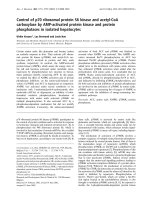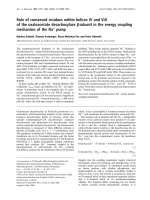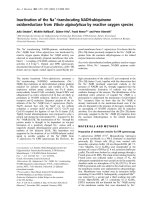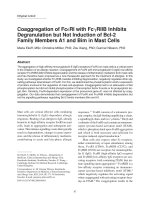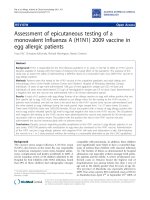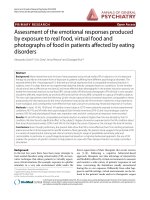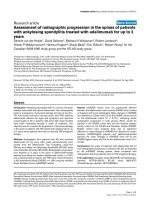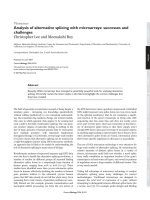Báo cáo y học: " Assessment of pulmonary antibodies with induced sputum and bronchoalveolar lavage induced by nasal vaccination against Pseudomonas aeruginosa: a clinical phase I/II study" pot
Bạn đang xem bản rút gọn của tài liệu. Xem và tải ngay bản đầy đủ của tài liệu tại đây (813.33 KB, 10 trang )
BioMed Central
Page 1 of 10
(page number not for citation purposes)
Respiratory Research
Open Access
Research
Assessment of pulmonary antibodies with induced sputum and
bronchoalveolar lavage induced by nasal vaccination against
Pseudomonas aeruginosa: a clinical phase I/II study
Ulrich Baumann*
1
, Kerstin Göcke
1
, Britta Gewecke
1
, Joachim Freihorst
1,2
and
Bernd Ulrich von Specht
3
Address:
1
Department of Paediatric Pulmonology and Neonatalogy, Hanover Medical School, Carl-Neuberg Str. 1, 30625 Hannover, Germany,
2
Pediatric Hospital, Ostalb-Klinikum, 73430 Aalen, Germany and
3
Centre for Clinical Research, Freiburg University, Breisacherstr.66, 79106
Freiburg, Germany
Email: Ulrich Baumann* - ; Kerstin Göcke - ; Britta Gewecke - ;
Joachim Freihorst - ; Bernd Ulrich von Specht -
* Corresponding author
Abstract
Background: Vaccination against Pseudomonas aeruginosa is a desirable albeit challenging strategy
for prevention of airway infection in patients with cystic fibrosis. We assessed the immunogenicity
of a nasal vaccine based on the outer membrane proteins F and I from Pseudomonas aeruginosa in
the lower airways in a phase I/II clinical trial.
Methods: N = 12 healthy volunteers received 2 nasal vaccinations with an OprF-OprI gel as a
primary and a systemic (n = 6) or a nasal booster vaccination (n = 6). Antibodies were assessed in
induced sputum (IS), bronchoalveolar lavage (BAL), and in serum.
Results: OprF-OprI-specific IgG and IgA antibodies were found in both BAL and IS at comparable
rates, but differed in the predominant isotype. IgA antibodies in IS did not correlate to the
respective serum levels. Pulmonary antibodies were detectable in all vaccinees even 1 year after
the vaccination. The systemic booster group had higher IgG levels in serum. However, the nasal
booster group had the better long-term response with bronchial antibodies of both isotypes.
Conclusion: The nasal OprF-OprI-vaccine induces a lasting antibody response at both, systemic
and airway mucosal site. IS is a feasible method to non-invasively assess bronchial antibodies. A
further optimization of the vaccination schedule is warranted.
Background
Prevention of chronic airway infection with Pseudomonas
aeruginosa is a major goal in therapy of cystic fibrosis (CF)
patients. We and others developed vaccines for use in CF
based on various pseudomonal antigens, including
lipopolysaccharides, toxin A, flagella, alginate, and outer
membrane proteins [1-4]. Our vaccine antigen is a recom-
binant fusion protein of the highly conserved outer mem-
brane proteins OprF and OprI from P. aeruginosa. The
OprF-OprI vaccine was shown to afford protection in var-
ious animal models and to be safe and immunogenic in
several clinical trials [5-7]. In an attempt to enhance the
formation of antibodies at the airway surface, the site of
the P. aeruginosa infection in CF, we pursued a nasal vac-
Published: 5 August 2007
Respiratory Research 2007, 8:57 doi:10.1186/1465-9921-8-57
Received: 29 March 2007
Accepted: 5 August 2007
This article is available from: />© 2007 Baumann et al; licensee BioMed Central Ltd.
This is an Open Access article distributed under the terms of the Creative Commons Attribution License ( />),
which permits unrestricted use, distribution, and reproduction in any medium, provided the original work is properly cited.
Respiratory Research 2007, 8:57 />Page 2 of 10
(page number not for citation purposes)
cination strategy. Nasal vaccination is known to specifi-
cally induce an antibody response of the bronchus-
associated lymphoid tissue (BALT) resulting in an
enhanced at the upper and lower airways [8,9]. The nasal
OprF-OprI gel vaccine was well tolerated and elicited a
reliable systemic immune response in experimental and
clinical studies [4,10,11].
The present study continues the work on the nasal OprF-
OprI gel vaccine. Our aims were to assess the antibody for-
mation at the pulmonary airway surface, to assess the per-
sistence of antibody levels after one year, and to compare
two vaccination schedules.
Assessment of antibodies in the human lower airways
raises the question of the appropriate method. Vaccine
induced pulmonary antibodies have been obtained by
bronchoalveolar lavage (BAL) [9,12] However, BAL is a
relatively invasive measure preventing its use in larger
clinical trials. Moreover, BAL fluid (BALF) has a predomi-
nantly alveolar site of origin and may not adequately rep-
resent the antibody composition at the bronchial surface.
This prompted us to investigate whether the well-estab-
lished technique of induced sputum (IS) is a way to relia-
bly assess antibodies from the bronchial airways. IS is
used for diagnostic procedures in a number of airway dis-
eases, including CF and chronic obstructive pulmonary
disease (COPD), in both children and adults [13,14]. We
evaluated the feasibility of the IS technique for assessment
of bronchial antibodies in comparison to BAL.
The second aim was to assess the antibody systemic and
mucosal antibody response not only immediately follow-
ing immunization, but also after one year. The kinetics of
mucosal antibody formation may not necessarily have
similar kinetics as the systemic antibody response due to
their differential induction and regulation mechanisms
[8].
Finally, we compared two variants of nasal vaccination
schedules. We investigated whether the immunogenicity
of the nasal OprF-OprI vaccine can be enhanced by a sys-
temic booster vaccination. A systemic booster vaccination
was effective in augmenting the mucosal antibody
response to the oral polio live vaccine [15].
The present study establishes IS as a valuable method to
obtain antibodies from the bronchial surface not repre-
sented by BAL. The nasal OprF-OprI engendered a lasting
systemic and mucosal immune response irrespective of
the booster schedule.
Methods
Production of the Vaccines
The nasal and systemic OprF-OprI vaccines were pro-
duced as described [6,10]. Briefly, the hybrid protein
(Met-Ala-[His]
6
OprF190-342-OprI21-83) consisting of
the mature outer membrane protein I (OprI) and amino
acids 190–342 of OprF of P. aeruginosa, was expressed in
E. coli and purified by Ni2
+
chelate-affinity chromatogra-
phy [5]. For the nasal vaccine, an aqueous solution of the
OprF-OprI protein was emulsified into a gel containing
1% OprF-OprI, 45% sodium dodecyl sulfate (Merck,
Darmstadt, Germany), and 5% aerosil (Caesar and
Lorenz, Hilden, Germany). The final concentration was
10 mg OprF-OprI/ml. For the systemic vaccine, OprF-
OprI protein was adsorbed to aluminum hydroxide
(Superfos, Vedbaeck, Denmark) and diluted into normal
saline, together with thimerosal (Caesar and Lorenz,
Hilden, Germany) as a preservative. The final concentra-
tions were 0.1 mg OprF-OprI/ml, 0.3 mg Al(OH)
3
/ml and
0.05 mg thimerosal/ml.
Subjects
12 male, healthy subjects (mean age 24.3, range 21 to 26
years) participated in the study. Exclusion criteria were
any chronic condition, such as diseases of the nose,
immune deficiencies, a previous P. aeruginosa infection, or
regular use of drugs. The volunteers gave a detailed medi-
cal history and underwent a physical examination prior to
the study, including examination of the nasal cavity by an
ENT-specialist. Total IgG and IgA levels in serum and IgA
levels in saliva were obtained in order to exclude an as yet
unknown humoral immune defect prior to inclusion in
the study.
All subjects gave written informed consent. The study was
in accordance to the Helsinki declaration, approved by
the ethics committee of Hanover Medical School, and reg-
istered with the German authority for vaccines and sera
(Paul-Ehrlich Institute, Langen, Germany).
Study Design
All subjects received a nasal primary followed by a nasal
booster vaccination (day 0 and 21, respectively). At day
42, the second booster was given either nasally (n = 6,
"nasal booster group"), or systemically (n = 6, "systemic
booster group"). The participants were assigned to the
schedule by drawing lots to ensure equal numbers for
both groups. For nasal vaccination, 100 μl of the emulgel,
containing 1 mg OprF-OprI, were placed on the cranial
side of the middle concha nasalis by a 24 gauge Teflon
cannula. Systemic vaccination was performed by injection
of 1 ml, containing 100 μg OprF-I, into the deltoid mus-
cle.
Respiratory Research 2007, 8:57 />Page 3 of 10
(page number not for citation purposes)
Serum and induced sputum (IS) were obtained 1 day
prior to the primary vaccination (day -1), at day 70, i.e. 4
weeks after the second booster vaccination, and after 1
year. Bronchoalveolar lavage (BAL) was performed prior
to the first vaccination and 4 weeks after the second
booster vaccination. BAL was performed 24 hrs after the IS
sampling procedure.
Data on tolerability and the mean values of OprF-OprI
specific antibody levels in serum at weeks 0 and 10 were
published previously [11].
Surveillance
The vaccinees were observed clinically for 4 h after each
vaccination and after the BAL procedures. The body tem-
perature was obtained prior to and 1, 4, 12, 24, 48, and 72
hrs after each vaccination. The local and systemic
responses were graded on a scale from 0 to 3, with the
respective scores representing absent, mild, moderate, and
severe reactions. Reactions to the vaccine were assessed for
3 consecutive days and documented by the volunteers. In
addition, each volunteer underwent a physical examina-
tion 2 days after each vaccination. Blood samples were
drawn prior to the vaccination, as well as 2 and 14 days
after each vaccination. The samples were assessed for full
blood count, evaluation of liver enzymes, creatinine, and
urea.
BAL was performed in accordance to the ERS taskforce rec-
ommendations [16]. Briefly, a flexible bronchoscope (BF
P40, Olympus, Hamburg, Germany) was used for instilla-
tion of 5 × 20 ml of normal saline with the bronchoscope
placed in the middle lobe bronchus in wedge position.
BAL samples were immediately placed on ice and subse-
quently centrifuged at 60 × g and 4 for 10 min. For analy-
sis of the cellular content, cytospots were performed with
200 μl of native BAL at 55 × g for 10 minutes and stained
with May Grünwald/Giemsa
Enumeration of the cytospots revealed normal cellular
proportions in all samples, with mean proportions as fol-
low: macrophages, 90.1 ± 4.7 (SD)%; lymphocytes, 8.0 ±
4.8%; and neutrophils, 1.3 ± 0.7%). The recovery rates
were 36 ± 5.2% and 43 ± 3.8% in the first and second BAL
procedures, respectively. Analysis of BAL fluid from one
subject in the nasal booster group was excluded due to a
haemorrhagic sample.
Induced Sputum
Sputum induction was performed in accordance to the
ERS guidelines with the exception of use of 5.85% saline
solution (Braun, Melsungen, Germany) [17]. Briefly,
inhalation time was 2 min, followed by oral cleansing
with water, drying of the mouth, and subsequent sputum
expectoration over a period of 3 min. The procedure was
repeated five times. Sputum samples were collected sepa-
rately, immediately placed on ice, and stored at -80°C.
The recovered volumes of IS were 6.0 ± 0.8 ml and 13.2 ±
1.3 ml in the first and second sampling, respectively.
Development of the Method for Antibody Detection in
Sputum
The use of IS for antibody detection had to be evaluated
prior to the study, as the procedure was not described in
the literature. We used sputum expectorated by CF
patients with chronic P. aeruginosa infection. As IS is com-
monly mixed with dithiothretiol (DTT) to separate its cel-
lular and mucous contents, we first tested whether
antibody detection in sputum was either improved or
impaired by this additive. Sputum specimens from 3 CF
patients who gave written informed consent for use of the
specimen were gently mixed 1:1 with a working solution
of 0.1% DTT in normal saline (Calbiochem, Bad Soden,
Germany) according to the manufacturer's instructions,
or with normal saline. The specimens were subsequently
centrifuged at 4 and 17,000 × g for 30 min. The superna-
tants showed similar levels of OprF-OprI specific anti-
body levels in ELISA irrespective of the use of either DTT
or NaCl 0.9%. DTT was therefore not used further for spu-
tum antibody analysis.
Next, we analyzed whether high-speed centrifugation
would improve the rate of antibody extraction. Sputum
was centrifuged at 4 either for 4 h at 120,000 × g, or for 30
min at 17,000 × g. The antibody levels in supernatants
were comparable irrespective of the centrifugation tech-
nique. We therefore used conventional centrifugation.
Finally, we investigated whether anti proteases would
improve the extraction rate of antibodies from the sputum
of CF patients. We added 2 μl 0.5 M ethylene diamine
tetraacetic acid (EDTA) and 1 μl of a 100 mM phenyl
methyl sulfonyl fluoride (PMSF) solution in isopropanol
to 100 μl of unprocessed CF – sputum, in order to inhibit
the activity of metalloproteases and serine proteases,
respectively. Supernatants of sputa treated with protease
inhibitors showed OprF-OprI-specific IgG and IgA anti-
body levels that were two- to threefold higher than those
of untreated specimens. Protease inhibitors were therefore
used for the study. It remains, however, unclear whether
the addition of protease inhibitors was necessary, since
the IS of the healthy volunteers is likely to have minimal
protease content compared to sputum from chronically
infected CF patients.
Blood Samples
Blood samples were stored overnight at 4 without antico-
agulants and centrifuged at 7,800 × g for 10 min. The
supernatant was frozen at -80 until analysis.
Respiratory Research 2007, 8:57 />Page 4 of 10
(page number not for citation purposes)
ELISA assays
96-well microtiter plates were coated with OprF-OprI at 1
μg/ml, blocked by a 0.2% bovine serum albumin (BSA,
Sigma, Munich, Germany) solution, and incubated with
100 μl/well of serum diluted at 1:2,000, with unconcen-
trated BAL, or with supernatant of sputum diluted at 1:2
for 2 h at 37. Binding was visualized with peroxidase-con-
jugated IgG- or IgA-specific binding rabbit antihuman sec-
ondary antibodies (Dako, Hamburg, Germany, the
Binding Site, Birmingham, UK), diluted 1:10,000, with
tetra methyl benzidine (TMB, Sigma-Aldrich, Munich,
Germany) as the chromogen. After 30 min of incubation
at room temperature, the reaction was stopped with 1 M
sulfuric acid. The extinction was read at λ = 450 nm. All
assays were performed in duplicate. Antibody levels are
given as arbitrary ELISA units (EU) based on the optical
density (OD) multiplied by the dilution factor and nor-
malized against an internal standard serum. An immune
response to the vaccination was considered positive only,
if the EU was more 50% above the individual pre-vaccina-
tion value.
Statistics
Mean values are given together with the standard error of
the mean (SEM). Mean values of independent groups
were compared by two-sided Student's t-test following the
estimation of equality of the variance by Levene's test or
by paired-samples t-tests, as appropriate. Correlations
were calculated with the product moment correlation
coefficient (Pearson's coefficient). Linear regression anal-
ysis was used to calculate a regression line, with ELISA
units in serum as independent variables, and in BAL or IS
as dependent variables.
A p value of less than 0.05 was considered significant. Cal-
culations were performed with the SPSS program V.14
(SPSS Inc., Chicago, IL, USA).
Results
Systemic antibody response
All vaccinees had a pronounced and lasting immune
response with formation of IgG and IgA antibodies in
serum irrespective of the the vaccination protocol (Figure
1A, and 1B, Table 1). After 1 year, antibody levels
appeared to drop moderately. However, this reached sta-
tistical significance only in for IgG antibodies in the nasal
booster group. The nasal booster group showed also a
trend (p = 0.05) towards lower levels at 4 weeks compared
to the systemic booster group (Figure 1A).
Mucosal antibody response
At 4 weeks, specific antibodies were detectable in the
majority of subjects in both, BALF and IS (Figure 1C–F,
Table 1). In BALF, however, antibodies were predomi-
nantly of IgG isotype. The systemic booster group had sig-
nificantly higher levels of IgG antibodies than the nasal
booster group. In contrast to the serum antibody
response, antibodies in IS were higher at 1 year than at 4
weeks, reaching statistical significance in the nasal booster
group for both isotypes (Figure 1E, and 1F).
Sequential analysis of BALF and IS
Analysis of the single fractions of BALF showed an
increase of IgG levels and concomitantly a decrease of IgA
levels, resulting in an increase of the IgG to IgA ratio (fig-
ure 2A, and 1C). In IS, however, IgG to IgA antibody levels
and their ratio remained largely unchanged in all fractions
(Figure 2B, and 2D). The first two fractions of BALF were
indifferent in their IgG to IgA ratios to the ratios of IS.
Correlation of systemic and mucosal antibody levels
Antibody levels in BALF correlated strongly to the related
serum levels with both isotypes (Figure 3A, and 3B). There
was also a correlation between antibody levels of IS and
serum, albeit more weakly and restricted to the IgG iso-
type. IgA antibodies in IS were not correlated to IgA levels
in serum. Antibodies in IS and BALF showed no signifi-
cant correlation (Figure 3E, and 3F).
Discussion
This study shows that the nasal OprF-OprI vaccine
induces a immune response not only in serum, but also in
the lower airways. The observation that antibodies were
detectable in both compartments after 1 year at high levels
suggest a lasting immunogenicity and a high responder
rate of this anti pseudomonal vaccination strategy. Assess-
ment of pulmonary antibodies showed a comparable sen-
sitivity of BAL and IS. However, the different proportions
of the isotypes suggest that the two methods represent at
least in part different areas of the lower airways. The origin
of fractional BAL samples is known to advance from the
bronchial to the alveolar compartment of the lower air-
ways [18]. Accordingly, we found high concentrations of
IgG antibodies, the predominant isotype in the alveolar
space, in the 3
rd
to the 5
th
BAL fraction, and higher IgA
concentrations, the predominant isotype on the bronchial
mucosa, in the1st and 2
nd
BAL fraction [19]. The IgG to
IgA ratio in IS was comparable to the composition of first
2 BAL fractions. Studies comparing cellular components
obtained with BAL and IS support a differential origin of
the samples with IS deriving from the central airways
[14,20]. This suggests that the antibody composition on
the bronchial mucosa is relatively stable over larger parts
of the bronchial tree.
IgG antibody levels in serum correlated well to the levels
in BALF and, albeit more weakly, in IS. IgG is thought to
reach the alveoli by passive diffusion from the systemic
circulation, and subsequently move by mucociliary trans-
port towards the central airways [19]. IgG in the bronchial
Respiratory Research 2007, 8:57 />Page 5 of 10
(page number not for citation purposes)
Individual OprF-OprI-specific IgG (left column) and IgA (right columns) antibody levels in ELISA units in serum (upper panel), pooled bronchoalveolar lavage fluid (BALF, middle panel, and supernatant of induced sputum (IS, lower panel) prior to the vac-cination (open circles), 4 weeks and 1 year after the booster vaccinationFigure 1
Individual OprF-OprI-specific IgG (left column) and IgA (right columns) antibody levels in ELISA units in serum (upper panel),
pooled bronchoalveolar lavage fluid (BALF, middle panel, and supernatant of induced sputum (IS, lower panel) prior to the vac-
cination (open circles), 4 weeks and 1 year after the booster vaccination. N = 12 volunteers received 2 applications with 1 mg
of a nasal OprF-OprI gel vaccine, followed by either a third nasal vaccination (nasal booster group, closed circles, n = 6), or by
a systemic vaccination with 100 μg OprF-OprI protein (systemic booster group, closed diamonds, n = 6). Mean values are indi-
cated by the line. Mean values of the groups were compared with the paired, two-sided t-test and a p value of less than 0.05
considered significant. * assign significant differences of mean values to the pre-vaccination values, # between mean values at 4
weeks and 1 year, and §between the vaccination groups. For clarity of the figure, pre vaccination levels of both vaccination
groups are shown together.
Respiratory Research 2007, 8:57 />Page 6 of 10
(page number not for citation purposes)
airways may then be complemented by antibodies pro-
duced locally as suggested by the presence of IgG positive
antibody secreting cells in the lamina propria [21]. The
weak correlation of IgG antibodies in IS to serum IgG is
consistent with this dual origin of bronchial IgG antibod-
ies.
IgA antibody levels in IS showed no correlation to sys-
temic and BALF antibody levels of this isotype. These find-
ings are consistent with a bronchial origin of the
antibodies regulated differently than the systemic immu-
nity [8]. Bronchial IgA predominantly derives from anti-
body secreting cells located in the lamina propria of the
bronchial mucosa and not from the systemic circulation
[21].
The present study is, to our knowledge, the first to use IS
for assessment of vaccine induced antibodies. The rela-
tively homogeneous results suggest that the method is
technically feasible and applicable in individuals who do
not expectorate spontaneous sputum. But is this method
clinically meaningful? The answer obviously depends on
the condition addressed by a vaccine. In CF, P. aeruginosa
infection affects predominantly the bronchial mucosa
[22]. A strong immunogenicity at the bronchial mucosa,
therefore, may be particularly desirable for anti pseu-
domonal vaccines for patients with CF. With IS represent-
ing the bronchial antibody composition better than
pooled BALF or serum, this technique may be usefully
applied in the process of optimization of the vaccination
strategy.
The use of IS for detection of vaccine induced antibodies
has limitations. A major drawback of the IS technique is
its age restriction [23]. Assessment of mucosal antibody
response in infants and pre-school age children, the pri-
mary target group for CF, has to resort to other strategies,
such as the detection of ASC with mucosal homing recep-
tors. It has also to be noted that the presence of bronchial
antibodies does not necessarily translate into protection.
In the present study we assessed the efficacy of a com-
bined nasal primary systemic booster vaccination com-
pared to a solely nasal vaccination schedule. The systemic
booster vaccination induced a stronger and more lasting
systemic IgG antibody response. A more frequent nasal
vaccination as performed in the nasal booster group, how-
ever, was more efficient in the induction of a long term
immune response at the bronchial mucosa with both IgG
and IgA isotypes. Both schedules, therefore, do not appear
ideal. Further research on mucosal and/or vaccination
schedules is warranted.
A surprising finding was that antibody levels in IS were
higher after 1 year than the post vaccination levels
obtained at 4 weeks. A technical error such as a an inap-
propriate ELISA procedure seems unlikely as all assays
used the same positive and negative control sera, and the
concomitant assessment of serum antibodies did show
the expected decrease in the 1 year specimen. However,
mucosal vaccination and antibody formation may not
necessarily follow the same kinetics. While is appears
unlikely that mucosal antibody formation rises after 1
year, the first assessment at 4 weeks may have missed the
peak of mucosal antibody formation.
The findings of the present study facilitate the further
development of the OprF-OprI vaccine. Current studies
compare antibody levels at the bronchial surface engen-
dered by the systemic, nasal and a newly developed oral
vaccine all based on the same antigen in healthy volun-
teers and in patients with chronic lung disease. It also
Table 1: Responder rates
IgG 4 weeks 1 year
nasal booster systemic booster nasal booster systemic booster
Serum 6/6 6/6 6/6 6/6
BALF 4/5 6/6 n.a. n.a.
Induced Sputum 3/6 5/6 5/5 5/5
IgA 4 weeks 1 year
nasal booster systemic booster nasal booster systemic booster
Serum 6/6 6/6 6/6 6/6
BALF 1/5 3/6 n.a. n.a.
Induced Sputum 4/6 3/6 5/5 5/5
Responder rates for OprF-OprI-specific IgG (left part of the table) and IgA (right part) antibody formation in serum, pooled bronchoalveolar lavage
fluid (BALF), and supernatant of induced sputum (IS) 4 weeks and 1 year after the vaccination. For vaccination schedule refer to Figure legend 1. An
antibody response was considered positive, if the post-vaccination ELISA unit was 50% or more above the individual pre-vaccination level. Data are
given numbers of individuals with positive response vs. the total number of vaccinees of this group. n.a. = not applicable, since BAL was performed
at 4 weeks only.
Respiratory Research 2007, 8:57 />Page 7 of 10
(page number not for citation purposes)
Sequential analysis of OprF-OprI-specific IgG (closed circles, straight line) and IgA antibodies (open circles, dotted line) in single fractions of bronchoalveolar lavage fluid (BALF, A and C) and induced sputum (IS, B and D) of n = 12 healthy volunteers vacci-nated with nasal primary and a nasal or systemic booster vaccinationFigure 2
Sequential analysis of OprF-OprI-specific IgG and IgA antibodies in single fractions of bronchoalveolar lavage fluid (BALF, A and
C) and induced sputum (IS, B and D) of n = 12 healthy volunteers vaccinated with nasal primary and a nasal or systemic
booster vaccination. Specimen were obtained 4 weeks after the booster vaccination. The upper panel shows the antibody lev-
els in ELISA units, the lower panel the ratio of the IgG to the IgA levels. Data are given as values (circles) and standard error of
the mean (SEM, lines). Antibody composition changed significantly between the first 2 and the consecutive samples in BAL,
while it remained stable in all fractions in IS. Mean values of ratios were compared by two-sided paired t-test. A p-value of less
than 0.05 was considered significant. * indicate significant differences to the first 2 fractions.
Respiratory Research 2007, 8:57 />Page 8 of 10
(page number not for citation purposes)
Individual levels of OprF-OprI-specific IgG (left colms) and IgA values (right column) given as correlation between bronchoalve-olar lavage fluid (BALF) and serum (upper panel), between induced sputum and serum (middle panel) and between induced sputum and BALF (lower panel) obtained 4 weeks after completion of the vaccination schedule in n = 12 volunteersFigure 3
Individual levels of OprF-OprI-specific IgG (left colms) and IgA values (right column) given as correlation between bronchoalve-
olar lavage fluid (BALF) and serum (upper panel), between induced sputum and serum (middle panel) and between induced
sputum and BALF (lower panel) obtained 4 weeks after completion of the vaccination schedule in n = 12 volunteers. Lines rep-
resent linear regression in cases of where correlation is significant. Pearson's product moment correlation cofficients of corre-
lation (r) and levels of significance (p) are given as numerical data in each section.
Respiratory Research 2007, 8:57 />Page 9 of 10
(page number not for citation purposes)
remains to be shown whether the OprF-OprI vaccine can
be effective in patients with CF and other conditions.
Recent data of a phase III clinical trial with CF patients
evaluating a bivalent flagella vaccine of P. aeruginosa sug-
gest that a protein based vaccine can be protective in CF
patients. However, protection was shown only against
those P. aeruginosa strains that expressed a vaccine type of
the flagella protein [24]. Our OprF-OprI based vaccine is
based on an antigen which is cross-reactive against all
serotypes of P. aeruginosa appears to be a promising can-
didate for further vaccine development aimed to protect
patients with CF from chronic P. aeruginosa airway infec-
tion.
Conclusion
We conclude that the nasal OprF-OprI vaccine induces a
lasting antibody response in serum and the lower airways.
Antibodies at the bronchial surface can be non-invasively
assessed by IS. A systemic booster is not effective to further
enhance the airway immunogenicity of the nasal OprF-
OprI vaccine. Recent data of a phase III clinical trial with
a flagella vaccine support both the promise of protein
based vaccines and the need for further optimization of
the vaccine strategy. Our present study which employs a
vaccine with a broad cross-reactivity may facilitate further
vaccine development by the use of the IS technique.
Competing interests
UB and BuvS receive funding under a grant from the cen-
tre for innvation and technology (ZIT), Vienna, Austria,
for a joint Pseudomonas vaccine project conducted
together with an affiliate of Intercell AG, Vienna, Austria.
Authors' contributions
UB lead and evaluated the study and wrote the manu-
script; KG recruited the volunteers, assisted in the sam-
pling procedures, and performed the ELISA
measurements as part of her medical thesis; BG assisted at
the ELISA procedures; JF performed the bronchoalveolar
lavage; BUvS developed and produced the OprF-OprI vac-
cine and wrote the grant application; All authors read and
approved the final manuscript.
Acknowledgements
We thank Prof. Matthias Griese for evaluation of the BALF cytology.
This work was supported by the German Cystic Fibrosis Foundation, Muk-
oviszidose e.V., Bonn.
References
1. Doring G, Dorner F: A multicenter vaccine trial using the Pseu-
domonas aeruginosa flagella vaccine IMMUNO in patients
with cystic fibrosis. BehringInstMitt 1997:338-344.
2. Lang AB, Rudeberg A, Schoni MH, Que JU, Furer E, Schaad UB: Vac-
cination of cystic fibrosis patients against Pseudomonas aer-
uginosa reduces the proportion of patients infected and
delays time to infection. PediatrInfectDisJ 2004, 23:504-510.
3. Pier G: Application of vaccine technology to prevention of
Pseudomonas aeruginosa infections. Expert Rev Vaccines 2005,
4:645-656.
4. Baumann U, Mansouri E, von Specht BU: Recombinant OprF-OprI
as a vaccine against Pseudomonas aeruginosa infections. Vac-
cine 2004, 22:840-847.
5. Knapp B, Hundt E, Lenz U, Hungerer KD, Gabelsberger J, Domdey H,
Mansouri E, Li Y, von Specht BU: A recombinant hybrid outer
membrane protein for vaccination against Pseudomonas
aeruginosa. Vaccine 1999, 17:1663-1666.
6. Mansouri E, Gabelsberger J, Knapp B, Hundt E, Lenz U, Hungerer KD,
Gilleland HE Jr, Staczek J, Domdey H, von Specht BU: Safety and
immunogenicity of a Pseudomonas aeruginosa hybrid outer
membrane protein F-I vaccine in human volunteers. InfectIm-
mun 1999, 67:1461-1470.
7. Mansouri E, Blome-Eberwein S, Gabelsberger J, Germann G, von
Specht BU: Clinical study to assess the immunogenicity and
safety of a recombinant Pseudomonas aeruginosa OprF-
OprI vaccine in burn patients. FEMS ImmunolMed Microbiol 2003,
37:161-166.
8. Kunkel EJ, Butcher EC: Plasma-cell homing. NatRevImmunol 2003,
3:822-829.
9. Rudin A, Riise GC, Holmgren J: Antibody responses in the lower
respiratory tract and male urogenital tract in humans after
nasal and oral vaccination with cholera toxin B subunit. Infec-
tImmun 1999, 67:2884-2890.
10. Larbig M, Mansouri E, Freihorst J, Tummler B, Kohler G, Domdey H,
Knapp B, Hungerer KD, Hundt E, Gabelsberger J, von Specht BU:
Safety and immunogenicity of an intranasal Pseudomonas
aeruginosa hybrid outer membrane protein F-I vaccine in
human volunteers. Vaccine 2001, 19:2291-2297.
11. Gocke K, Baumann U, Hagemann H, Gabelsberger J, Hahn H, Frei-
horst J, von Specht BU: Mucosal vaccination with a recombinant
OprF-I vaccine of Pseudomonas aeruginosa in healthy volun-
teers: comparison of a systemic vs. a mucosal booster sched-
ule. FEMS ImmunolMedMicrobiol 2003, 37:167-171.
12. Doring G, Pfeiffer C, Weber U, Mohr-Pennert A, Dorner F:
Parenteral application of a Pseudomonas aeruginosa flagella
vaccine elicits specific anti-flagella antibodies in the airways
of healthy individuals. Am J Respir Crit Care Med 1995,
151:983-985.
13. Ho SA, Ball R, Morrison LJ, Brownlee KG, Conway SP: Clinical value
of obtaining sputum and cough swab samples following
inhaled hypertonic saline in children with cystic fibrosis. Pedi-
atr Pulmonol 2004, 38:82-87.
14. Rutgers SR, Timens W, Kaufmann HF, van der Mark TW, Koeter GH,
Postma DS: Comparison of induced sputum with bronchial
wash, bronchoalveolar lavage and bronchial biopsies in
COPD. EurRespirJ 2000, 15:109-115.
15. Herremans TM, Reimerink JH, Buisman AM, Kimman TG, Koopmans
MP: Induction of mucosal immunity by inactivated poliovirus
vaccine is dependent on previous mucosal contact with live
virus. JImmunol 1999, 162:5011-5018.
16. Haslam PL, Baughman RP: Report of ERS Task Force: guidelines
for measurement of acellular components and standardiza-
tion of BAL. Eur Respir J 1999, 14:245-248.
17. Paggiaro PL, Chanez P, Holz O, Ind PW, Djukanovic R, Maestrelli P,
Sterk PJ: Sputum induction. Eur Respir J Suppl 2002, 37:3s-8s.
18. Ratjen F, Bredendiek M, Brendel M, Meltzer J, Costabel U: Differen-
tial cytology of bronchoalveolar lavage fluid in normal chil-
dren. Eur Respir J 1994, 7:1865-1870.
19. Pilette C, Ouadriri Y, Godding V, Vaerman JP, Sibille Y: Lung
mucosal immunity: immunoglobulin-A revisited. EurRespirJ
2001, 18:571-588.
20. Keatings VM, Evans DJ, O'Connor BJ, Barnes PJ: Cellular profiles in
asthmatic airways: a comparison of induced sputum, bron-
chial washings, and bronchoalveolar lavage fluid. Thorax 1997,
52:
372-374.
21. Brandtzaeg P: Induction of secretory immunity and memory at
mucosal surfaces. Vaccine 2006.
22. Potts SB, Roggli VL, Spock A: Immunohistologic quantification of
Pseudomonas aeruginosa in the tracheobronchial tree from
patients with cystic fibrosis. Pediatr Pathol Lab Med 1995,
15:707-721.
23. Jones PD, Hankin R, Simpson J, Gibson PG, Henry RL: The tolera-
bility, safety, and success of sputum induction and combined
Publish with BioMed Central and every
scientist can read your work free of charge
"BioMed Central will be the most significant development for
disseminating the results of biomedical researc h in our lifetime."
Sir Paul Nurse, Cancer Research UK
Your research papers will be:
available free of charge to the entire biomedical community
peer reviewed and published immediately upon acceptance
cited in PubMed and archived on PubMed Central
yours — you keep the copyright
Submit your manuscript here:
/>BioMedcentral
Respiratory Research 2007, 8:57 />Page 10 of 10
(page number not for citation purposes)
hypertonic saline challenge in children. AmJRespirCrit Care Med
2001, 164:1146-1149.
24. Doring G, Meisner C, Stern M: A double-blind randomized pla-
cebo-controlled phase III study of a Pseudomonas aerugi-
nosa flagella vaccine in cystic fibrosis patients. Proc Natl Acad
Sci U S A 2007, 104:11020-11025.
